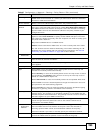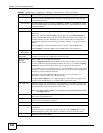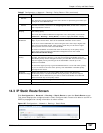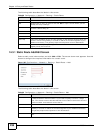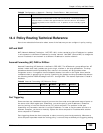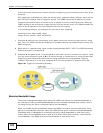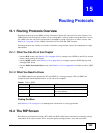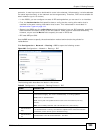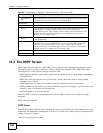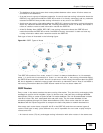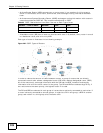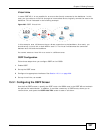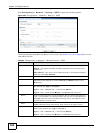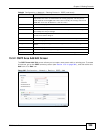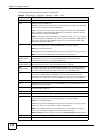
Chapter 15 Routing Protocols
ISG50 User’s Guide
303
protocols, it uses hop count to decide which route is the shortest. Unfortunately, it also broadcasts
its routes asynchronously to the network and converges slowly. Therefore, RIP is more suitable for
small networks (up to 15 routers).
• In the ISG50, you can configure two sets of RIP settings before you can use it in an interface.
•First, the Authentication field specifies how to verify that the routing information that is
received is the same routing information that is sent. This is discussed in more detail in
Authentication Types on page 312.
• Second, the ISG50 can also redistribute routing information from non-RIP networks, specifically
OSPF networks and static routes, to the RIP network. Costs might be calculated differently,
however, so you use the Metric field to specify the cost in RIP terms.
• RIP uses UDP port 520.
Use the RIP screen to specify the authentication method and maintain the policies for
redistribution.
Click Configuration > Network > Routing > RIP to open the following screen.
Figure 200 Configuration > Network > Routing > RIP
The following table describes the labels in this screen.
Table 92 Configuration > Network > Routing Protocol > RIP
LABEL DESCRIPTION
Authentication
Authentication Select the authentication method used in the RIP network. This authentication
protects the integrity, but not the confidentiality, of routing updates.
None uses no authentication.
Text uses a plain text password that is sent over the network (not very
secure).
MD5 uses an MD5 password and authentication ID (most secure).
Text
Authentication
Key
This field is available if the Authentication is Text. Type the password for
text authentication. The key can consist of alphanumeric characters and the
underscore, and it can be up to 8 characters long.
MD5
Authentication
ID
This field is available if the Authentication is MD5. Type the ID for MD5
authentication. The ID can be between 1 and 255.



